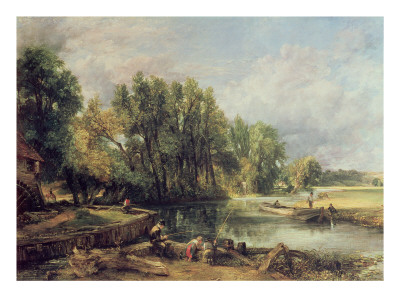Constable painted "Stratford Mill" in 1820. It is a lovely large landscape, oil on canvas, measuring 127 x 182.9 cm. It is part of a group of six important Constable landscapes featuring life on the River Stour in Suffolk, a group which includes the more famous "The Hay Wain", Constable's first successful painting.
"Stratford Mill" was first put on public display in 1820, the same year as the picture's completion, at the Royal Academy. Its recent history is interesting: under the acceptance-in-lieu procedure of 1987, it has been accepted for tax debit amounting to 5.5 million pounds, and it now hangs in London's National Gallery, permanently on display for all to view and enjoy. It has recently been part of an exhibition of British paintings in the Yale Centre For British Art at Yale University, USA.
Constable has produced a number of pictures featuring mills, although in this painting we get just half a mill, over on the left hand side. John's father was a miller and as a young lad John was an apprentice in his father's profession, but John was not destined to become a miller. Recognising the boy's artistic talent, his father agreed when young John decided to study art in London. With this background, it is not surprising that the mill is a recurring scene in Constable's landscapes. The mill in this painting, the Stratford watermill, was employed in the manufacture of paper; unfortunately, it no longer exists, having been demolished in the last century.
The very first edition of "The Compleat Angler" by Izaak Walton was published in 1653 and other expanded and enhanced versions of this "fisherman's bible" followed. Written in a mix of prose and verse, it is Walton's combined manual/homage/celebration of the art of fishing. To honour Walton, and the dignity and prestige that he brought to this activity, sportive anglers have since come to be known as "Waltonians".
In the "Stratford Mill" painting, the fishing rods catch the eye more than the mill itself. Subsequently, due to the predominance and central positioning of young people intent on making a catch from the banks of the river, this picture is also known as "The Young Waltonians", an alternative name which came into vogue after the painter's death in 1837.
The name of John Constable is indelibly associated with peaceful and sublimely rendered scenes of the English countryside. His soft and dreamy landscapes communicate a sense of bucolic tranquillity and a humble appreciation of the pageant of nature.
John Constable was inspired by, and receptive to, the steady parade of changing nature, particularly in the beautiful Dedham Vale area in Suffolk where he grew up, and which is known as "Constable Country".
He was born in East Bergholt in rural Suffolk in 1776, and his paintings are mostly agricultural and nature-inspired. He is the quintessential landscape artist, with rich rural scenes, as in "Stratford Mill", depicting the slow-paced country life-style, here characterised by fishing and messing about on the river on a lazy afternoon.
The soothing pastoral charm and shimmering nature-packed background communicate carefree serenity and sweet fresh air, you can almost hear the ripple of the water and the buzz of a bee.




